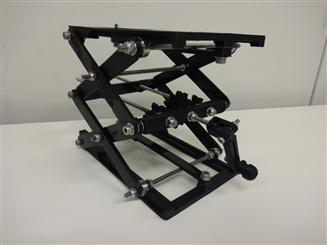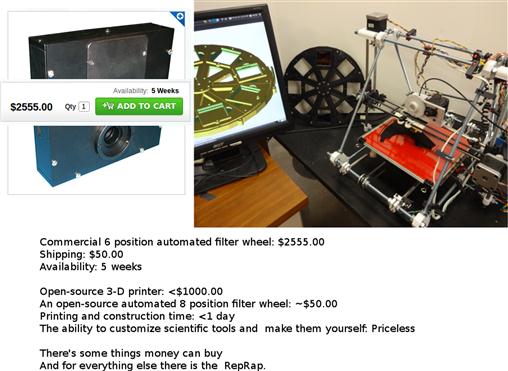Preface
As the process of development that has succeeded in free and open-source software is now being applied to hardware, an opportunity has arisen to radically reduce the cost of experimental research in the sciences while improving the tools that we use. Specifically, the combination of open-source 3-D printing and open-source microcontrollers running on free software enables the development of powerful research tools at unprecedented low costs. In this book, these developments are illustrated with numerous examples to lay out a path for reinforcing and accelerating free and open-source scientific hardware development for the benefit of science and society. Wise scientists will join the open-source science hardware revolution to see the costs of their research equipment drop as their work becomes easier to replicate and cite.
Most scientists who do experimental work are familiar with and somewhat acclimated to the often extreme prices we pay for scientific equipment. For example, last year, I received a quote for a $1000 lab jack. A lab jack is not an overly special or sophisticated research tool; it simply moves things up and down like a jack for a car, only more precisely and the “things” it has to move are much smaller. That price for the application I was planning on using it for (moving millimeter-scale solar photovoltaic cells into a beam of light) was absurd, but as many researchers in academia know, the prices are effectively multiplied because of institutional overheads. Thus, at my institution for example, where we pay 71% overhead for industry-sponsored research, purchasing that lab jack would demand that I raise $1710 from sponsors! Historically, you, I and the rest of the scientific community had no choice—we had to buy proprietary tools to participate in state-of-the-art research or develop everything from scratch. Thus, we had to choose between paying exorbitant fees or investing a lot of our own time as even the simplest research tools like a lab jack are time-consuming to fabricate from scratch. No more! Now the combination of open-source microcontrollers and 3-D printers enables all of us to fabricate low-cost scientific equipment with far less-time investment than ever possible in the history of science. If you want the complete digital designs of a lab jack, you can print for a few dollars (Figure 1).1 In fact, for $1710, you could buy yourself a nice 3-D printer and print hundreds of lab jacks and other high-value equipment for your friends, colleagues and family! Scientists have been catching on and the files for the lab jack have already been downloaded thousands of times.

FIGURE 1 An open-source lab jack. A lab jack is a height-adjustable platform ideal for mounting optomechanical subassemblies that require height adjustment. This lab jack was developed by the Michigan Tech Open Sustainability Technology Lab group primarily by Nick Anzalone and the gears were developed by Thingiverse user: GregFrost. The OpenSCAD files (raw source code), STL files (for printing) and instructions can be found at http://www.thingiverse.com/thing:28298.
Lower cost and less-time investment are actually only secondary benefits of using open-source hardware in your lab. The main advantages of the “open-source way” in science is customization and control. Rather than buy what is on the shelf or available from vendors online, you can create scientific instruments that meet your exact needs and specifications. This really is priceless (Figure 2). The ability to customize research tools is particularly helpful to those on the bleeding edge of science, which need custom, never-seen-before equipment to make the next great discovery. If the tools and software you use to run your experiments are open source, you and your lab group have complete control over your lab. If you hold the code, your lab will never be left empty handed (or stuck with extremely expensive paper weights) when commercial vendors go out of business, drop a product line, or lose key technical staff. Every research university in the world is sitting on millions of dollars of broken scientific equipment that is too expensive or time-consuming to repair. With open-source hardware, these problems largely evaporate. Similarly, if you only use open-source hardware rather than locked-down proprietary tools, your lab cannot be held for ransom by dishonest hardware vendors. It is perhaps important to note here that “open source” does not necessarily mean “free” as we will discuss in Chapter 1. Making open-source hardware following the process outlined in this book almost always results in much lower costs. However, the open-source scientific hardware movement is still developing and all the research tools you need may not have been developed yet. For scientific hardware that we do not fabricate in our own lab, we will pay a premium for open-source equipment and free software because of the access to the control or simply because it is superior (as discussed in Chapter 2). I am far from alone in thinking this way. One of the computers I am typing this book on is running a version of Linux2 developed by Red Hat. Although Red Hat’s software is freely available for download on the Internet, they make over US$1 billion per year essentially selling service to help people maintain it and optimize it for their applications.

FIGURE 2 The ability to customize high-quality research-grade scientific equipment is priceless, yet it often costs orders of magnitude less than conventional proprietary tools.
In our lab, whenever possible, we want control over our own equipment, thus we use open-source hardware and software as much as possible. We now develop the majority of our tools in at least some way using the open-source paradigm. Now we have joined a virtuous cycle—as our research group shares our designs for research equipment with others, they make them better and share their improvements back with us. I should be clear here; this goes far beyond simple benevolent sharing or charity. Our lab equipment quality improves because we actively share. In this way, we all benefit.
For those working at academic, government and industry laboratories, this book is meant to be an introductory guide on how to join and take advantage of all the benefits of open-source hardware for science. Chapter 1 covers the basics of open source, a brief overview of the history and etiquette of open-source communities. The theoretical argument for why this method of technological development is superior to the standard models is laid out in Chapter 2, which describes why nice guys finish first both in research and at the industrial scale. Chapter 3 covers the nitty-gritty of open-source licensing. Chapters 4 and 5 describe the two most useful tools for fabricating open-source scientific equipment, the Arduino microcontroller and RepRap 3-D printer, respectively. Chapter 6 is the heart of the book and describes digital designs for open-source scientific hardware in physics, engineering, biology, environmental science and chemistry. Finally, in Chapter 7, we take a peek at the future and possible ramifications of large-scale adoption of open-source hardware and software for science.
A note to readers: This book is not necessarily the kind of text you read from cover to cover. If you are already “at one with the force of open source” and just want to get your hands dirty—start building by skipping to Chapter 4. Similarly, only a few of the examples in Chapter 6 will be relevant to your work—no need to learn about PCR if you are a physicist researching new nanoscale solid-state detector technologies—just go right to the tools that will be most helpful to you… share and enjoy.
1.1 Standard Disclaimer
Knowledge and best practice in this field are constantly changing. As new research and experience broaden our understanding, changes in research methods, professional practices, or safety may become necessary.
Practitioners and researchers must always rely on their own experience and knowledge in evaluating and using any information, methods, equipment, compounds, or experiments described herein. In using such information or methods, they should be mindful of their own safety and the safety of others, including parties for whom they have a professional responsibility.
To the fullest extent of the law, neither the Publisher nor the author, contributors, or editors assume any liability for any injury and/or damage to persons or property as a matter of products liability, negligence or otherwise, or from any use or operation of any methods, products, instructions, or ideas contained in the material herein.
Associate Professor Department of Materials Science & Engineering Department of Electrical & Computer Engineering Michigan Technological University Houghton, MI USA
1http://www.thingiverse.com/thing:28298
2Linux is a free and open-source computer operating system, which comes in many varieties. The majority of the rest of the book was written on a laptop running Ubuntu Linux (http://www.ubuntu.com/) and my lab is currently making the transition to Debian (http://www.debian.org/).